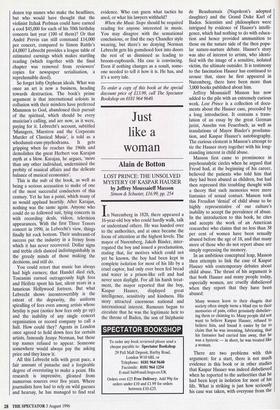Just like a woman
Main de Botton
LOST PRINCE: THE UNSOLVED MYSTERY OF KASPAR HAUSER by Jeffrey Moussaieff Masson
Simon & Schuster, f16.99, pp. 254
In Nuremberg in 1828, there appeared a 16-year-old boy who could hardly walk, talk or understand others. He was handed over to the authorities, and at once became the focus of attention at the highest levels. The mayor of Nuremberg, Jakob Binder, inter- rogated the boy and issued a proclamation, stating that, for motives which could not yet be known, the boy had been kept in complete isolation for most of his life by a cruel captor, had only ever been fed bread and water in a prison-like cell and had never seen daylight. For all his harsh treat- ment, the mayor reported that the boy, Kaspar Hauser, displayed great intelligence, sensitivity and kindness. His story attracted enormous national and international interest. Rumours began to circulate that he was the legitimate heir to the throne of Baden, the son of Stephanie
de Beauhamais (Napoleon's adopted daughter) and the Grand Duke Karl of Baden. Scientists and philosophers were intrigued by evidence of Hauser's intelli- gence, which had nothing to do with educa- tion and hence provided ammunition to those on the nature side of the then popu- lar nature-nurture debate. Hauser's story was also of interest to artists, who identi- fied with the image of a sensitive, isolated victim, the ultimate outsider. It is testimony to the fascination Hauser has continued to arouse that, since he first appeared in Nuremberg, there have been more than 3,000 books published about him.
Jeffrey Moussaieff Masson has now added to the pile with an extremely curious work. Lost Prince is a collection of docu- ments about the Hauser case, preceded by a long introduction. It contains a trans- lation of an essay by the great German jurist, Anselm von Feuerbach, as well as translations of Mayor Binder's proclama- tion, and Kaspar Hauser's autobiography. The curious element is Masson's attempt to tie the Hauser story together with his long- standing interest in child abuse.
Masson first came to prominence in psychoanalytic circles when he argued that Freud had, at the beginning of his career, believed the patients who told him that they had been abused as children, but had then repressed this troubling thought with a theory that such memories were mere fantasies of sexual contact. Masson took this Freudian 'denial' of child abuse to be highly representative of our culture's inability to accept the prevalence of abuse. In the introduction to this book, he cites and accepts the work of an American researcher who claims that no less than 38 per cent of women have been sexually abused before the age of 18, and that many more of those who do not report abuse are simply repressing the memory.
In an ambitious conceptual leap, Masson then attempts to link the case of Kaspar Hauser with contemporary debates about child abuse. The thrust of his argument is that both Hauser and many people today, especially women, are cruelly disbelieved when they report that they have been abused:
Many women learn to their chagrin that society often simply turns a blind eye to their memories of pain, either genuinely disbeliev- ing them or claiming to. Many people did not want to believe Kaspar Hauser, refused to believe him, and found it easier by far to claim that he was inventing, fabricating, that his fantasies had carried him away, that he was a hysteric — in short, he was treated like a woman.
There are two problems with this argument: for a start, there is not much evidence in this book or in other studies that Kaspar Hauser was indeed disbelieved when he reported to the authorities that he had been kept in isolation for most of his life. What is striking is just how seriously his case was taken, with everyone from the mayor of Nuremberg to von Feuerbach doing their utmost for the boy. Secondly, it would be difficult to argue that this age is really indifferent to abused people, or to go along with Masson's extraordinary sugges- tion that child abuse is 'the most denied fact' of the 20th century.
Masson tells us: There were many who doubted, on no very solid ground, the story of Kaspar Hauser, and claimed that he fabricated his early life of trauma, just as there are people who believe no account of abuse.
These people no doubt do and did exist, but they hardly represent serious thinking, and do not deserve the attention Masson grants them.
Masson's attempt to connect Hauser and modem victims of abuse ends up doing justice to neither party, for he merely mud- dies Hauser's fascinating story with his extraordinary and largely unsubstantiated views about the prevalence of child abuse. This seems to be one book too many on the Hauser pile.



















































 Previous page
Previous page